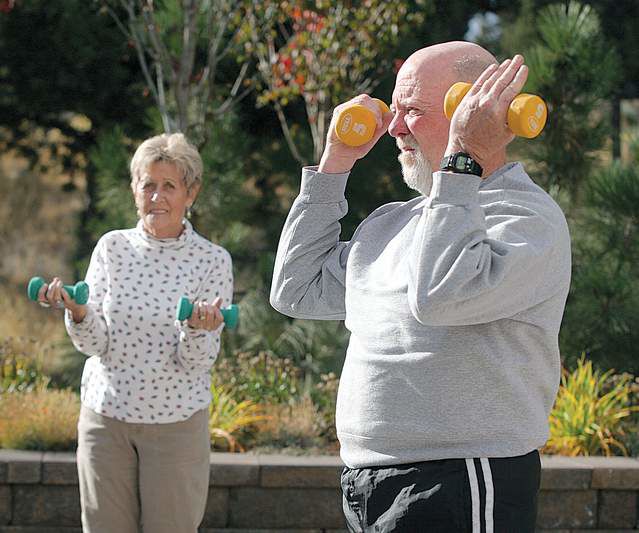Bulking up may stop as seniors start to age
Published 5:00 am Thursday, October 16, 2008

- Doreen Stratford, left, follows instructor Bill Gauvin’s lead at the Bend Senior Center in Bend. A new study suggests that people may stop being able to build muscle after age 80, making the years just prior very important.
Exercise has proven effective at keeping many of the unhappy consequences of old age at bay. It can stimulate the mind, help maintain the bones and reduce the big killers such as heart disease and cancer.
But a new study suggests that, at a certain point, some types of exercise may stop having the intended benefit. After age 80, resistance training programs such as weight lifting may not increase muscle.
A recent study found that men older than age 80 did not build muscle after a rigorous three-month strength training program. Previous studies had shown some changes in muscle mass, even in people in their 70s. The new findings could have implications for how people maintain strength and mobility into old age.
People “do get to a point,” where they are not able to build muscle, said Scott Trappe, an author of the study and director of the Human Performance Laboratory at Ball State University in Indiana. The study subjects, he said, “we were not able to put mass on these people at all.”
Trappe, who has done many similar studies with different age groups, said the findings were “alarming and somewhat surprising.” In every previous study, he said, “everybody gets bigger and stronger.”
The study was done on six men between the ages of 80 and 86 who had both their overall strength measured as well as biopsies to measure the mass of individual muscle fibers. Though the number of people in the study was small, Trappe said he was confident in the findings because all men showed the same results. Trappe said the lab has also done similar studies on women older than 80 with similar results.
The men in the study did get stronger over the course of the three-month study, Trappe said, because the men’s bodies got more efficient at using the strength they did have. However, the gain was only about half of what would be expected.
Though Trappe called the strength increase a “silver lining,” he said the lack of muscle increase was disheartening. Muscle mass, he said, is important for mobility and for balance. Trappe also said that people are increasingly finding that muscle mass is important for metabolic health, the way our body regulates weight, appetite and other functions. “We’re now realizing how important muscle is in helping regulate the overall health of the body.”
The study, however, should not be taken as an indictment of exercise for seniors. Strength training also has benefits for bone density and a positive effect on the brain chemicals that regulate mood, said Bill Gauvin, an instructor with the Bend Metro Park and Recreation District.
Gauvin leads a twice-weekly circuit training class at the Bend Senior Center where he works on muscle strength and balance with a group of seniors.
“You feel a lot better when you are finished,” said Kathy Kerins, who said she has been coming to the classes for about six months. She was diagnosed with an autoimmune disease about a year ago, she said, and credits the classes with helping her regain movement in her legs.
Trappe said that, as a practical matter, seniors should be doing weight training through their 60s and 70s. Once you hit retirement, he said, “spend some time and hit the weight room and build muscle mass before it’s too late.”
Trappe suggested that people should exercise at about 70 percent of their maximum weight capacity to build muscle. To find that line, use help and figure out the maximum weight that you can lift. Then, do three sets of 10 repetitions at least once a week at 70 percent of that maximum.
Most seniors, said Trappe, “need to be lifting more” to build muscle mass. “If you go less than that, you’re going through the motions but you’re not really turning the triggers on to make these kinds of changes.”






